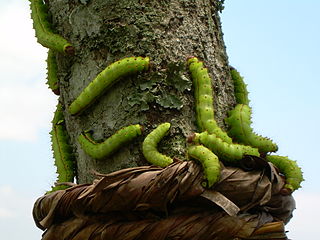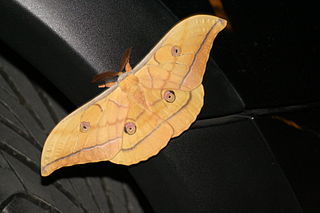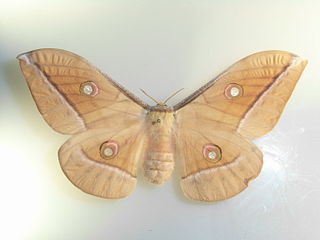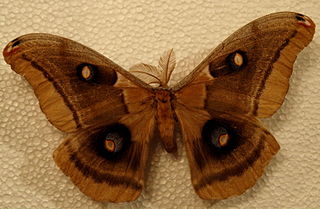
Moths are a paraphyletic group of insects that includes all members of the order Lepidoptera that are not butterflies, with moths making up the vast majority of the order. There are thought to be approximately 160,000 species of moth, many of which have yet to be described. Most species of moth are nocturnal, but there are also crepuscular and diurnal species.

Saturniidae, commonly known as saturniids, is a family of Lepidoptera with an estimated 2,300 described species. The family contains some of the largest species of moths in the world. Notable members include the emperor moths, royal moths, and giant silk moths.

Antheraea polyphemus, the Polyphemus moth, is a North American member of the family Saturniidae, the giant silk moths. It is a tan-colored moth, with an average wingspan of 15 cm (6 in). The most notable feature of the moth is its large, purplish eyespots on its two hindwings. The eyespots give it its name – from the Greek myth of the cyclops Polyphemus. The species was first described by Pieter Cramer in 1776. The species is widespread in continental North America, with local populations found throughout subarctic Canada and the United States. The caterpillar can eat 86,000 times its weight at emergence in a little less than two months.

The Saturniinae or saturniines are a subfamily of the family Saturniidae. They are commonly known as emperor moths or wild silk moths. They are easily spotted by the eyespots on the upper surface of their wings. Some exhibit realistic eye-like markings, whilst others have adapted the eyespots to form crescent moon or angular shapes or have lost their wing scales to create transparent windows. They are medium to very large moths, with adult wingspans ranging from 7.5 to 15 cm, in some cases even more. They consist of some of the largest groups of Lepidoptera like the moon or luna moth, atlas moth, and many more. The Saturniinae is an important source of wild silk and human food in many different cultures.
Helen Spurway Haldane was a British biologist and the second wife of J. B. S. Haldane. She emigrated to India in 1957 along with Haldane and conducted research in field biology along with Krishna Dronamraju, Suresh Jayakar, and others.

Wild silks have been known and used in many countries from early times, although the scale of production is far smaller than that from cultivated silkworms. Silk cocoons and nests often resemble paper or cloth, and their use has arisen independently in many societies.

Antheraea yamamai, the Japanese silk moth or Japanese oak silkmoth is a moth of the family Saturniidae. It is endemic to east Asia, but has been imported to Europe for tussar silk production and is now found in southeastern Europe, mainly in Austria, northeastern Italy, and the Balkans. It seems to be spreading north and a population has been reported near Deggendorf and Passau in Germany. The species was first described by Félix Édouard Guérin-Méneville in 1861. It has been hybridized artificially with Antheraea polyphemus of North America.

Antheraea is a moth genus belonging to the family Saturniidae. The genus was erected by Jacob Hübner in 1819. Several species of this genus have caterpillars which produce wild silk of commercial importance. Commonly called "tussar silk", the moths are named tussar moths after the fabric.

Antheraea assamensis, known as the muga silkworm as a larva and Assam silk moth as an adult, is a moth of the family Saturniidae. The species was first described by T. W. Helfer in 1837. It is found in Assam in northeast India where 99% of its production occurs.

Antheraea celebensis is a moth of the family Saturniidae first described by Watson in 1915. It is found in Sulawesi and Sundaland.

Antheraea larissa is a silkworm moth of the family Saturniidae found in Sundaland. The species was first described by Westwood in 1847. The larva feed on the endangered tree Shorea glauca.

Antheraea jana is a moth of the family Saturniidae first described by Stoll in 1782. It is found in Sundaland, the Andamans and Myanmar.

Antheraea rosieri is a moth of the family Saturniidae first described by Lambertus Johannes Toxopeus in 1940. It is found in Sumatra, Peninsular Malaysia and Borneo.

Antheraea pernyi, the Chinese (oak) tussar moth, Chinese tasar moth or temperate tussar moth, is a large moth in the family Saturniidae. The species was first described by Félix Édouard Guérin-Méneville in 1855. Antheraea roylei is an extremely close relative, and the present species might actually have evolved from ancestral A. roylei by chromosome rearrangement.

Antheraea paphia, the South India small tussore, is a species of moth of the family Saturniidae found in India and Sri Lanka.
Alphatetraviridae is a family of viruses. Moths and butterflies serve as natural hosts. There are currently ten species in this family, divided among 2 genera. Infection outcome varies from unapparent to lethal.
Antheraea cingalesa, the Sri Lankan tussar silk moth, is a moth of the family Saturniidae. The species was first described by Moore in 1883. It is endemic to Sri Lanka.

Antheraea oculea, known generally as the western Polyphemus moth or Arizona Polyphemus moth, is a species of silkmoth in the family Saturniidae. It is found in Central America and North America.
















